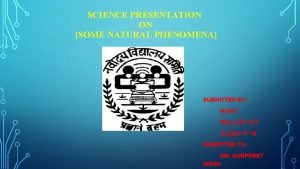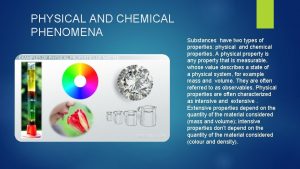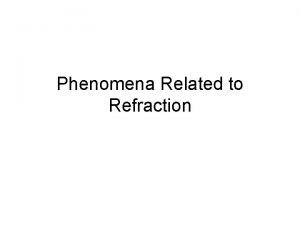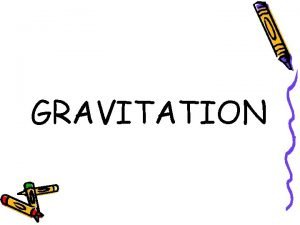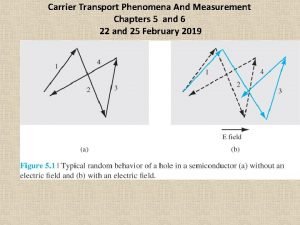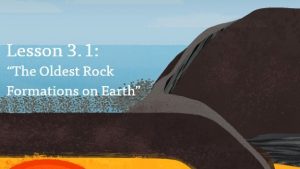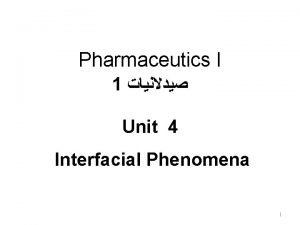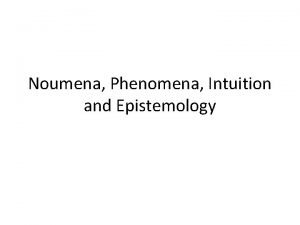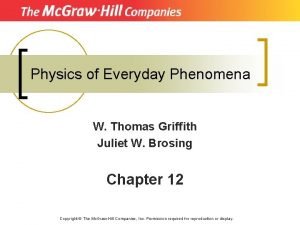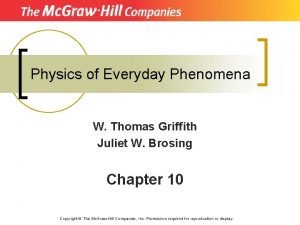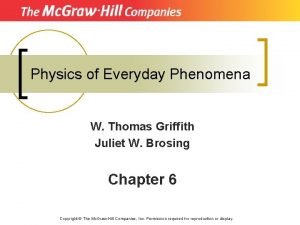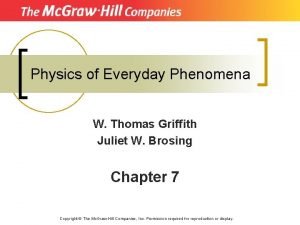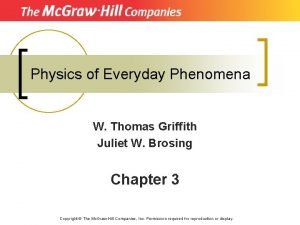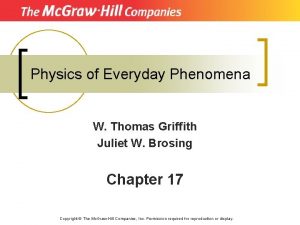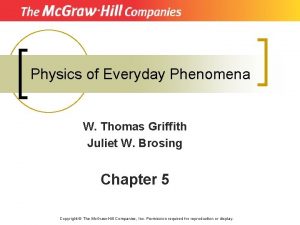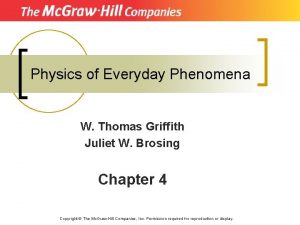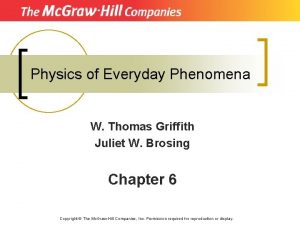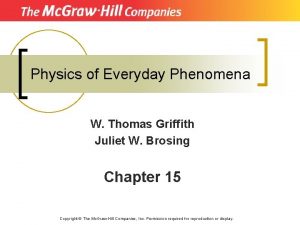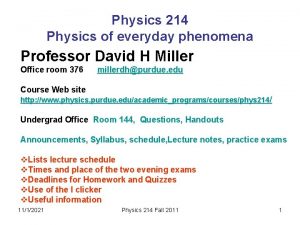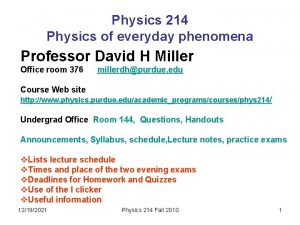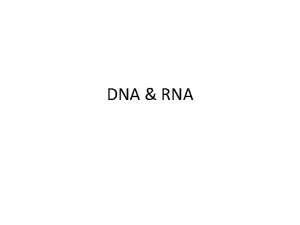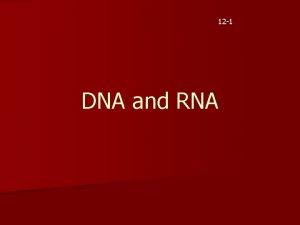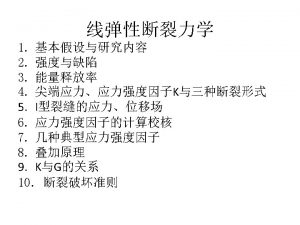Physics of Everyday Phenomena W Thomas Griffith Juliet



















- Slides: 19

Physics of Everyday Phenomena W. Thomas Griffith Juliet W. Brosing Chapter 16 Copyright © The Mc. Graw-Hill Companies, Inc. Permission required for reproduction or display.

Question 16. 1 In a vacuum the speed of light waves compared to the speed of radio waves is A) faster B) slower C) the same

Question 16. 2 Electromagnetic waves A) need a medium such as water to propagate B) travel faster in a medium such as water than they do in a vacuum C) are longitudinal waves D) travel at the same speed in a vacuum regardless of wavelength

Question 16. 3 If the wavelength of an electromagnetic wave is about the radius of the earth, what type of radiation is it? A) X-ray B) Visible light C) Microwave D) Radio wave E) Wavelengths can't be that big.

Question 16. 4 Which correctly represents the orientation of the electric field, magnetic field, and direction of propagation for an EM wave? A B C

Question 16. 5 Compared to red light, the wavelength of green light is A) longer B) the same length C) shorter

Question 16. 6 The part of the eye that distinguishes between different colors of light is the A) cornea B) lens C) cones D) rods

Question 16. 7 The pigments used in paints or dyes used on fabrics work by A) selective absorption B) birefringence C) polarization D) interference

Question 16. 8 The cones provide us with the ability to see color. In addition they A) are responsible for our night vision B) are responsible for our peripheral vision C) allow us to see fine detail in well lit conditions

Question 16. 9 In the figure shown, the A) green wave is in phase with the blue wave. B) red and blue waves differ in phase by 90 degrees. C) green and blue waves differ in phase by degrees. D) green and blue waves differ in phase by 360 degrees. E) both B and C.

Question 16. 10 In a two-slit experiment, if the wavelength of the incident light increases, the bright and dark lines in the interference pattern A) are unchanged. B) spread out. C) move closer together. D) disappear.

Question 16. 11 In a two-slit experiment, light rays from the two slits that reach the third maximum on one side of the central maximum travel distances that differ by _____. A) 3 l B) l C) l/3 D) 2 l/3

Question 16. 12 A laser is used to illuminate a double-slit experiment. What happens to the interference pattern if the distance between the slits is slowly increased? A) The fringes spread out. B) The fringes get narrower. C) The fringes stay the same.

Question 16. 13 Diffraction involves A) interference of light coming from different parts of the same slit or opening B) interference of light coming from different slits or openings C) the interaction of photons of light from different sources

Question 16. 14 In a single-slit experiment, the width of the slit is slowly decreased. The diffraction pattern A) remains unchanged. B) spreads out. C) shrinks together. D) fades away.

Question 16. 15 The colorful effects that we see when viewing a compact disc (CD) are due to A) The different colors embedded in the CD B) The absorption of certain colors C) The close spacing of the tracks which act as a diffraction grating

Question 16. 16 Light waves reflected off a body of water are strongly polarized in the horizontal direction. To reduce glare polarized sunglasses are made A) with the transmission axis horizontal. B) with the transmission axis vertical. C) with the transmission axis at 37°. D) Polarized sunglasses don’t help with glare

Question 16. 17 A beam of unpolarized light shines on a set of three polarizers as shown in the figure. The amount of light transmitted through them is A) zero. B) less than zero. C) more than zero.

Answer Key to Chapter 16 1) 2) 3) 4) 5) 6) 7) 8) A D D A C C A C 9) 10) 11) 12) 13) 14) 15) 16) 17) C B A B C
 Griffith thomas
Griffith thomas Pathologist and anthropologist
Pathologist and anthropologist An aircraft monikko
An aircraft monikko Some natural phenomena class 8 ppt free download
Some natural phenomena class 8 ppt free download Physical and chemical phenomena
Physical and chemical phenomena Phenomena related to refraction
Phenomena related to refraction Observable phenomena
Observable phenomena Objective phenomena
Objective phenomena Reference phenomenon in nlp
Reference phenomenon in nlp Reference phenomena in nlp
Reference phenomena in nlp Colloid examples
Colloid examples Gravitation is a natural phenomenon where
Gravitation is a natural phenomenon where Carrier transport phenomena
Carrier transport phenomena Anchor phenomena
Anchor phenomena Observable phenomenon
Observable phenomenon Surface and interfacial phenomena
Surface and interfacial phenomena Reoulox phenomena
Reoulox phenomena Global climate phenomena
Global climate phenomena Random phenomena
Random phenomena Phenomena vs noumena
Phenomena vs noumena



